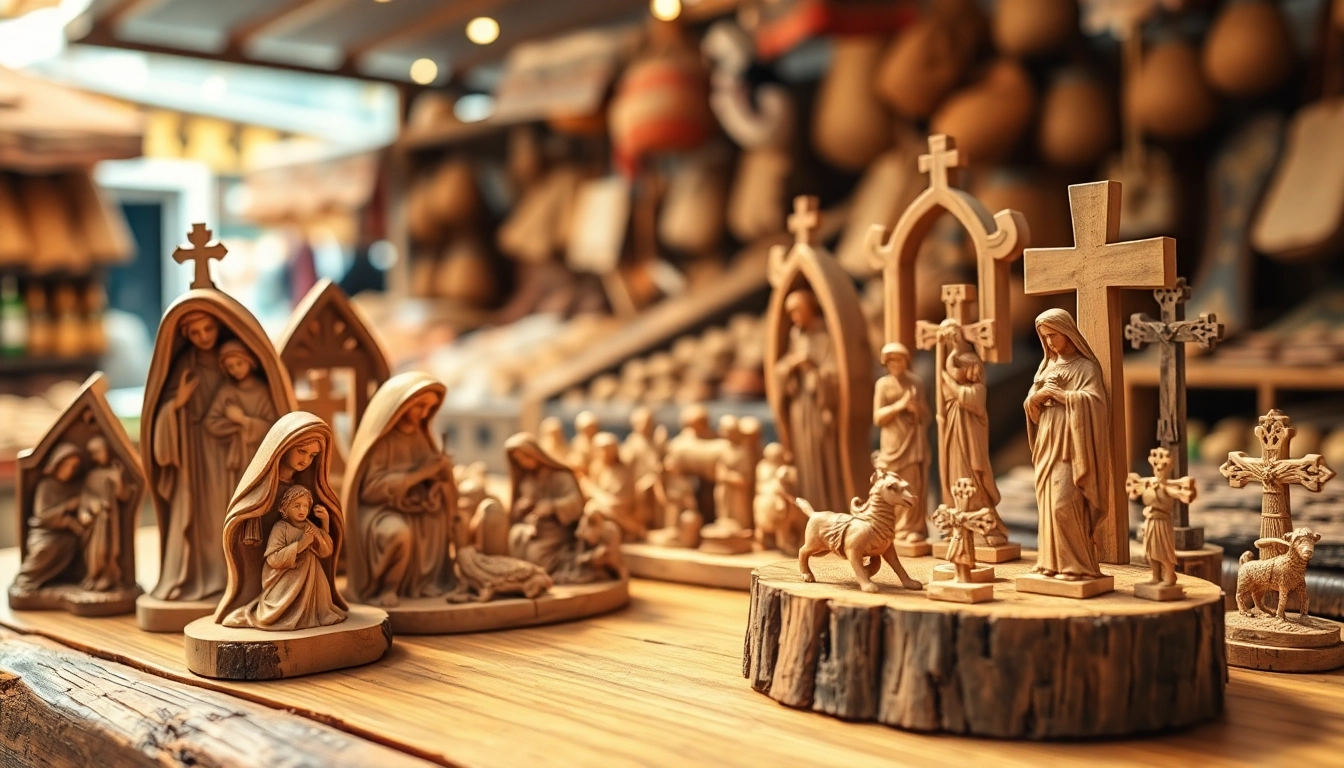Understanding Olive Wood Carvings
What are Olive Wood Carvings?
Olive wood carvings are intricate art pieces crafted from the wood of the olive tree, recognized for its durability, unique grain patterns, and rich, warm color. The craftsmanship is not only an artistic expression but also a cultural tradition that signifies the connection between the artisan and their heritage. These carvings can take various forms, including figurines, religious symbols, and decorative pieces, making them versatile items suitable for any home or collection. The character of olive wood adds prestige to each piece, embodying stories and historical significance through its aesthetic appeal and organic origins. You can explore a selection of exquisite olive wood carvings that showcase the beauty and artisanal skill behind this unique craft.
The Historical Significance of Olive Wood in Art
The olive tree holds significant cultural and historical resonance, particularly in the Mediterranean region, where its wood has been treasured for centuries. Historically, olive wood was used by ancient civilizations, including the Greeks and Romans, to create functional items such as utensils and furniture. However, it gradually transitioned into the artistic realm as artisans recognized its potential for detailed carvings.
In Bethlehem and Jerusalem, olive wood carving flourished through Christian history, particularly within the context of religious art. Artisans traditionally carved figures of saints, scenes from the Bible, and crosses, often used in churches and homes as expressions of faith. Furthermore, each carving is not just a representation of faith but also embodies the spirit of the local community, often being passed down through generations.
The Artistry Behind Olive Wood Carvings
Creating olive wood carvings is an elaborate process that requires skill, patience, and a profound understanding of the medium. Artisans begin by selecting the finest pieces of wood, which are typically sourced from the prunings of olive trees. This sustainable practice ensures the continuation of this ancient craft while promoting environmental preservation.
The carving process itself utilizes a variety of traditional tools, which may include chisels, knives, and sometimes even the artisans’ own hands to create intricate details. Carving requires a deep appreciation of the natural grain and texture of the wood, allowing the artisans to enhance the beauty of each piece. These works often combine aesthetic appeal with meaningful symbolism, engaging collectors and admirers alike.
Uses and Applications of Olive Wood Carvings
Religious Symbols and Decor
Among the most celebrated applications of olive wood carvings are those featuring religious symbols. Crosses, nativity scenes, and figures of saints are commonly carved from this beloved wood, serving as decorative items that hold spiritual significance. They are often found in homes, places of worship, or as gifts during significant religious occasions such as Christmas or baptisms. Their craftsmanship not only elevates the spiritual ambiance but also provides the owners with a tangible connection to their faith.
Gift Ideas Featuring Olive Wood
Olive wood carvings make for thoughtful and meaningful gifts. Whether it’s a hand-carved bowl, a sculpture, or a decorative cross, each piece tells a story that extends beyond its physical form. Gift-giving occasions, such as weddings, anniversaries, or religious celebrations, are perfect opportunities to share these unique pieces. Notably, many choose olive wood items as corporate gifts, symbolizing peace and longevity, values that resonate with many recipients.
Furthermore, personalized olive wood items—such as engraved keepsakes—provide a customized touch, making them even more special for the recipient. They serve as a reminder of the giver’s thoughtfulness and the shared cultural or religious significance behind the artwork.
Home Decor: Enhancing Spaces with Olive Wood Art
Incorporating olive wood carvings into home décor is an excellent way to add warmth and character to any space. From elegantly carved bowls and platters used as centerpieces to larger sculptures placed strategically around the home, each piece introduces an earthy, organic element that draws the eye and invites conversation.
Moreover, olive wood art can complement various interior design styles—from rustic and traditional to modern and minimalist. Accent pieces, such as olive wood lamps or wall hangings, create focal points that enhance the overall aesthetic while reflecting the owner’s personal style and appreciation for artisan craftsmanship.
Choosing Quality Olive Wood Carvings
How to Identify Authentic Olive Wood Carvings
When purchasing olive wood carvings, authenticity is key. Authentic pieces typically come with distinct characteristics that differentiate them from imitations. Quality olive wood carvings are usually fine-grained with visible variations in color and texture, showcasing the unique patterns inherent to the wood. Additionally, authentic products often bear the mark or signature of the artisan, which provides assurance of quality and authenticity.
Buyers should be cautious of mass-produced items, as these often lack the intricate detailing and unique touch of hand-carved pieces. Seeking items made directly by artisans in regions known for their woodworking traditions, such as Bethlehem, guarantees a more genuine experience.
Factors Affecting Quality and Price
Several factors affect the quality and price of olive wood carvings, including the quality of the wood itself, the skill of the artisan, and the complexity of the design. High-quality olive wood is typically sourced from older trees, as they produce wood with richer patterns and colors.
The skill level of the artisan also plays a prominent role; a seasoned craftsman will produce more refined and sophisticated carvings, justifying a higher price point. Additionally, the intricacy of the design affects pricing, as more complex pieces require more time and expertise to create. Moreover, buyers may encounter variations in pricing based on the location of the purchase, as items sourced directly from artisan markets may be more affordably priced than those offered through retailers.
Popular Styles and Designs
Olive wood carvings come in various styles and designs, each reflecting unique artistic traditions and cultural significances. Common styles include naturalistic forms, intricate patterns, and abstract representations. Rotating themes through the seasons and holidays is also common; for example, nativity scenes are especially popular during the Christmas season.
Current trends reflect a blend of traditional and contemporary styles, with many artisans experimenting with mixed media. Combining olive wood with metals, stones, or glass creates engaging and innovative pieces that attract a broader audience. However, traditional designs remain timeless, with classical figures and symbols continuing to hold great value among collectors.
Caring for Your Olive Wood Carvings
Maintenance Tips for Longevity
To ensure the longevity of olive wood carvings, proper maintenance and care are essential. Regular oiling is recommended to keep the wood hydrated and maintain its rich coloration. Food-safe mineral oils or specialized wood oils are suitable for this purpose, preventing the wood from drying out and cracking over time.
In addition to oiling, it is advisable to keep olive wood carvings away from direct sunlight and extreme humidity, which can warp or fade them. Placing these pieces in a stable environment helps preserve their integrity and beauty.
Cleaning and Storage Recommendations
Cleaning olive wood carvings should be done delicately to avoid damaging the wood. A soft, damp cloth is sufficient for routine cleaning. It’s crucial to avoid submerging the carvings in water or using abrasive cleaning agents that could scratch the surface.
If large carvings need to be stored, ensure they are kept in a dust-free environment, preferably in a wooden or fabric-lined case that allows for airflow. A careful approach to storage prevents damage and preserves the carvings’ artistic quality.
Restoration of Olive Wood Art
Over time, even the finest olive wood carvings may require restoration due to wear and tear. Restoration involves several steps, including cleaning, repairing any cracks or chips, and reapplying finishes or oils. It is essential to approach restoration with care, as improper techniques can lessen the piece’s integrity.
For valuable or antique pieces, it may be wise to consult professional restorers who specialize in wood art. They can provide expert advice and perform strategic repairs to restore the carving while maintaining its original character.
Where to Buy Olive Wood Carvings
Top Online Retailers and Marketplaces
For enthusiasts looking to purchase olive wood carvings, various online platforms offer an expansive selection. Websites dedicated to handcrafted and artisan goods, such as Etsy, often feature extensive collections from different regions, including dedicated artisan shops that source directly from craftsmen.
Additionally, specialty retailers focused on religious or cultural gifts sell quality olive wood carvings. Websites like Bethlehem Handicrafts and Holy Land Gift Shop provide direct access to authentic pieces crafted by skilled artisans.
Local Stores Specialized in Olive Wood Products
For those who prefer a tactile experience, local stores specializing in olive wood products also offer unique selections. Visiting cultural markets or artisan fairs often reveals hidden gems and allows buyers to connect with artisans and learn about the craft behind the products.
In areas with significant cultural heritage or communities that celebrate craftsmanship, local shops may feature olive wood sculptures, religious artifacts, and decorative items that can enhance any collection.
Supporting Artisans and Fair Trade Practices
Purchasing olive wood carvings not only yields beautiful décor but also supports artisans and their communities. Many small-scale producers rely on the sale of these items for their livelihoods. Supporting fair trade initiatives ensures that artisans receive fair compensation for their work, promoting sustainable practices in the crafting industry.
By choosing to invest in olive wood products from ethical sources, buyers can contribute to preserving these cultural traditions while fostering economic sustainability within artisan communities.



